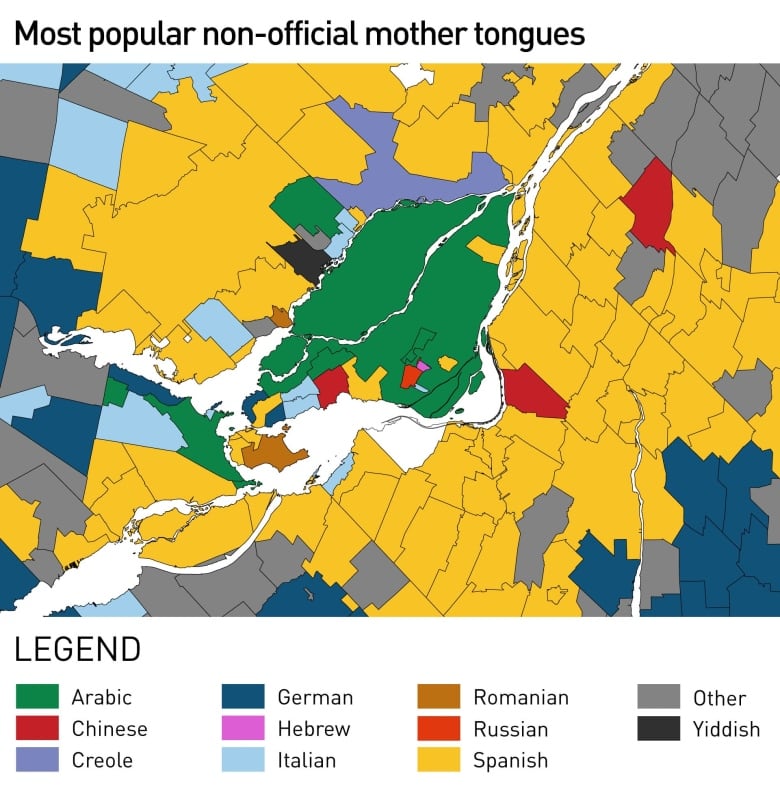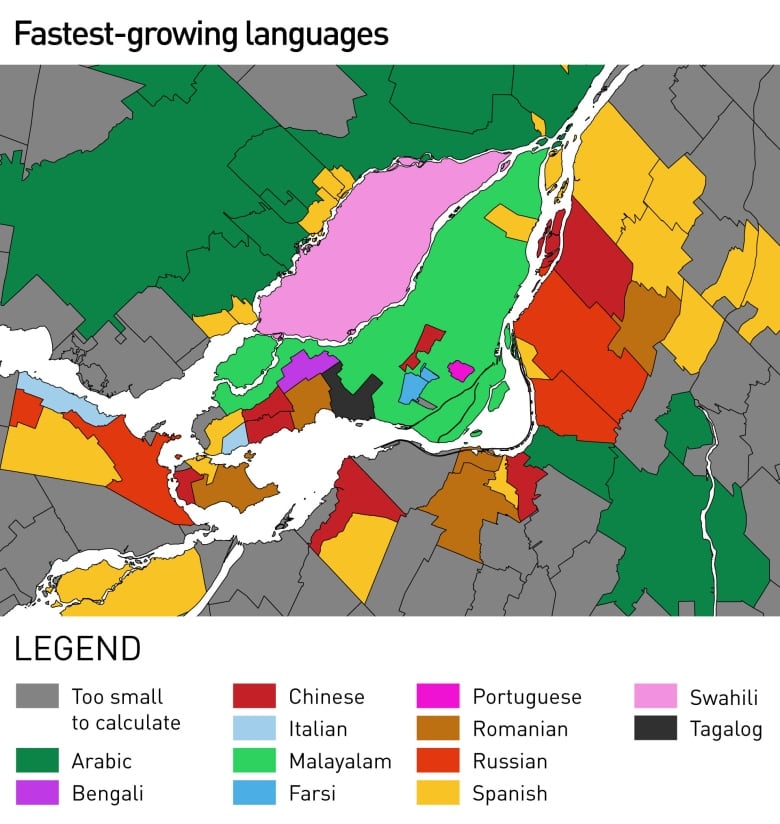Maps tell story of Montreal's changing linguistic landscape
Most popular, fastest-growing foreign languages might surprise you

The 2016 census showed that language diversity is growing in Canada. More than one out of every fiveCanadians said at home, they speak a language other than English or French.
A similar proportion said they speak more than one language at home.
A lot of this change is happening in Montreal.
Here are five maps that show how language is evolving in the metropolitan area.
Note: Although Statistics Canada has acknowledged there were problems with census numbers involving anglophones in Quebec, the agencysaid counts in Montreal are unaffected by the computer error that skewed language counts in some regions of the province.
Allophones are leaving the island
People whose mother tongue is neither English nor French have lived mainly on the island of Montreal and Laval. But that's changing as more and more allophones move to thesuburbs on Montreal'sSouth and North Shores.
"We've been seeing a dynamic of non-official languages spreading more outside the island of Montreal," milie Lavoie, a demographer at Statistics Canada, confirmed.
Most spoken foreign languages different here
In other large Canadian cities, the most common non-official languages tend to be Asian: Mandarin, Cantonese, Tagalog, Punjabi and Urdu.
In Montreal, however, Arabic, Spanish and Italian are predominant.
Much of thatcan be explained by Quebec's preference for immigrants who already speak French witnesstheinflux ofpeople from North African countries,who also speak Arabic or who speak languages close to French, such asSpanish and Portuguese.

The fastest-growing languages hint at new immigration
Montreal's main immigrant groups have historically been Italians, Greeks, Portuguese and people from the Caribbean.
But immigration from those countries hasebbed. The latest census shows that other countries are supplying the city's newer residents.
In the city of Montreal, the three fastest-growing languages are all from India:Malayalam, Telugu and Marathi.
Although their numbers are relatively small (Malayalam grew from 140 in 2011 to 250 speakers in 2016), they hint at a burgeoning Indian immigration.
Likewise, Laval had a big increase in Tamil and Bengali speakers, but the number of speakers of the East African language Swahili doubled in five years,to 120 people.
Farsi, the language of Iran, also saw an impressive bump, growing 43 per cent in five years, to 12,600 speakers in the city. It's also the fastest-growing language in the Montreal suburbs ofCte-Saint-Luc and Hampstead.

Spanish was the language that grew in the most municipalities in Quebec mostly in rural or suburban areas.
Municipalities where a language grew the most since 2011
(where there were at least 50 speakers in 2011)
Spanish: 25
Arabic: 20
Inuktitut: 13
Cree: 7
Chinese languages: 7
Romanian: 5
No competitionwith Toronto
There's a census tract in Cte-des-Neiges where 48 different languages are spoken in homes the most linguistically diverse area in the Montreal metropolitan region.
What's a census tract?
These are small zones in metropolitan areas with a population between 2,500 and 8,000 people.
What makes that even more impressive is that thislittle corner of Montreal, delineatedby DarlingtonAvenue, Jean-Talon Boulevard, Van HorneAvenue and Cte-des-NeigesRoad, only has a population of 6,600 and is less than half a square kilometre in size.
Some of the languages spoken includeTagalog, Arabic, Spanish, Vietnamese, Tamil, Bengali, and lesser known tongues likeIlocanoandHiligaynon(from the Philippines),WolofandFulah(West Africa)and Kabyle (Algeria).
Here's a close-up of the census tract, below left.Next to it, bordering Cte-Sainte-Catherine Road, another tract where47 languages are spoken at home.

Yet, thesepalein comparison with St. James Town in Toronto, which boasts 63 languages among 11,800 people.
Then there's Brittania Youngstown in Edmonton, with 59languages for 7,250 people.













_(720p).jpg)


 OFFICIAL HD MUSIC VIDEO.jpg)
.jpg)



























































































